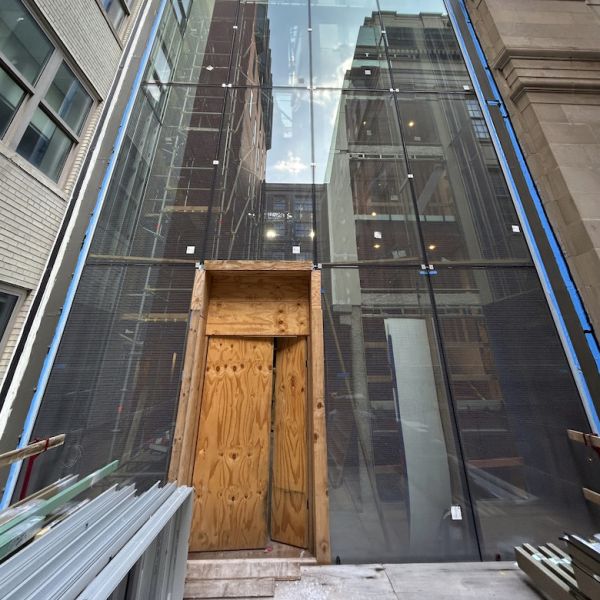In This Newsletter
Studies Show...
Funding Your Future
Finishing Touches: The Last Glass Panel Encloses Our Atrium
Dear friends,
Back-to-school season is a fall tradition, even as the face and form of education shift, often in exciting ways. Education is a powerful tool for changing a country’s cultural landscape and broadening access to resources. New tools like gamification, AR/VR, AI, and microlearning open doors. With the right design, tools can build empathy, support teachers and students on a human scale, and promote a focus on emotional and mental well-being.
This month, we’re not just learning, we’re listening. And we’re optimistic about what we’re hearing from several new polls designed to take public temperatures on the American Dream—and so are many Americans, per recent studies. Read on for the latest from The Sine Institute and the Los Angeles Times, updates from our Milken Institute colleagues, and more.
Rachel Goslins
Executive Director & Chief Creative Officer
Milken Center for Advancing the American Dream, Milken Institute
Studies Show...
The Sine Institute for Policy and Politics recently conducted a study—summarized by NPR and C-SPAN—whose major findings indicate that young people are optimistic about their futures but pessimistic about the impact of the political system on their lives. Six in ten Americans polled expect to have a better life than previous generations, but only one-third of young people expect to have a more representative and functional government than their parents.
Elsewhere in polling, the Los Angeles Times kicked off a series based on the findings of a landmark poll designed to give better public visibility into adult immigrants of different national origins. We’re excited to follow more stories from their findings, but here’s a taste of the numbers and sentiment:
“...the vast majority of immigrants say they came to the U.S. seeking better economic and job opportunities and a better future for themselves and their children.
Most say they've found both.
Eight in 10 immigrants surveyed said their financial situation was better because of moving to the U.S., and roughly 8 in 10 said educational opportunities for themselves or their children have improved because of immigrating.
Eight in 10 also said if they could go back in time and do it all again, they would still choose to emigrate.
And 7 in 10 who are parents said they expect that their children’s standard of living will exceed their own.”
The Times study focused on older generations of immigrants. Another study, from the Walton Family Foundation and Gallup, asks Gen Z how they think about themselves, their schools, and their possible futures. From the study, titled Voices of Gen Z:
- 76 percent of Gen Z agree they have a great future ahead of them, yet only 44 percent report feeling prepared for their future.
- 65 percent of Gen Z students with fair or poor mental health have missed school in the past month, compared with 41 percent of those with excellent mental health.
While it’s clear that much remains to be done to prepare these young Americans for their future, it’s heartening that they’re comfortable communicating their needs, which is key as we work to improve educational offerings.
Funding Your Future
In recent years, the Milken Institute has studied how Americans manage lifetime financial security by conducting research, meeting with experts, and hosting collaborative convenings. Now, its findings have been distilled into a new report, Shifting the Retirement Paradigm: Moving toward Lifetime Financial Security.
The report goes beyond the traditional understanding of financial well-being, defining lifetime financial security as having the ability to pay recurring monthly expenses, afford adequate housing, absorb a financial shock, set and meet short-term and long-term financial goals, have a tax-deferred savings plan to save for retirement, be financially prepared for long-term medical costs, and be comfortable with the lifestyle you live and can afford.
Key findings:
- Only 24 percent of workers feel very confident that they’ll be able to retire comfortably.
- 46 states have taken some action to implement a state-facilitated retirement savings program, study program options, or consider legislation to establish one.
- Age 25 is the latest Americans should start to invest for their future. Saving $100 a week at this age leads to savings of more than $1.1 million by age 65.
- At least 25 percent of Americans lack any retirement savings, and half have no access to employer-sponsored retirement plans.
- The SECURE 2.0 Act contains provisions that make it easier for more small businesses to create retirement plans, allowing for greater retirement savings across the population.
- College tuition and fees were nearly 1,500 percent higher in 2022 than in 1977. Students often spend years paying off loans instead of saving for retirement.
Finishing Touches: The Last Glass Panel Encloses Our Atrium
MCAAD’s construction team has reached yet another momentous milestone, as the final glass panel was installed to fully surround our atrium this month! The atrium, often referred to as the MCAAD campus’ “sixth building,” will showcase soaring ceilings, expansive glass panels, and lush greenery, all while situated in the heart of DC’s urban landscape.
The space is a creative endeavor and an architectural feat, as it was built in what was originally a service alley in the historic district. The atrium will be a convening hub for visitors to gather, enjoy café bites, and engage in public programs. It will also directly connect guests to MCAAD’s beautiful conference center, visitor center exhibits, and historic bank halls.

